Open Journal of Social Sciences
Vol.2 No.1(2014), Article ID:41718,14 pages DOI:10.4236/jss.2014.21009
Cycling as Innovation in Norway and Sweden*
University of Oslo, Oslo, Norway
Email: anders.gustavsson@ikos.uio.no
Received 10 October 2013; revised 15 November 2013; accepted 22 November 2013
ABSTRACT
This paper deals with the acceptance of a technical novelty, in this case cycling, during the late nineteenth and early twentieth century. Experiences and feelings are the focus. The analytical perspectives are: social status, economy, age, gender, work/leisure, safety/danger. The innovation process of cycling conducted by a contrast between two neighbouring countries of Norway and Sweden respectively. The oral source material is found in Norwegian and Swedish folklore ar-chives. The earliest design of bicycle was called velocipede. The bicycles began to appear around 1900. The first owners of bicycles were mostly well-to-do people in both rural and urban areas. As long as there was a shortage of bicycles, a certain collegiality existed, which implied that several people could use the same bike. Envy was also expressed in contrast to collective collegiality. Lady’s bicycles came somewhat later than men’s bikes. Children’s bicycles did not exist at first, so children were taught on adult bicycles. A major problem when bringing in bicycles was the bad road conditions in rural areas, especially in winter and at the spring thaw. Among the elder, the first velocipedes and bicycles could be perceived as a danger of supernatural character. Long weekend bike rides are mentioned in many cases from the 1930s, both in Norway and Sweden. Among cyclists, the expressions of positive feelings, as freedom, are clearly in majority. There were special conditions during the Second World War. One problem the cyclists then experienced was the total lack of rubber tyres. The difference between the neighbouring countries was that riders in Sweden were not subjected to the checks carried out by the German authorities in Norway.
Keywords:Collegiality; Folklore Narratives; Innovation; Second World War; Technical Novelty; Velocipede

1. Introduction
My paper deals with the acceptance of a technical novelty, in this case cycling, during the late nineteenth and early twentieth century. It will be a study of the experiences of both active cyclists and their surroundings during the first period of innovation and also later changes up to the mid-twentieth century. What are the feelings, both good and bad ones? As experiences and feelings are the focus of this study, it will be a narrative study. Since I do not focus on bicycles as material objects, I must present background information about them. I have not studied sporting activities. I compare the innovation process and the consequent changes in the two neighbouring countries of Norway and Sweden respectively. My study is included in a newly commenced international network on Cycling: past, present and future, initiated by the University of Lund, Sweden (cf. [1]).
My source material is found in Norwegian and Swedish folklore archives. In Norway, autobiographies were collected from ordinary people spreaded across the country on three occasions: in 1964 for writers born before 1900, in 1981 for those before the First World War, and in 1996 for those born before the year of 1930. The narratives are especially concerned with the first half of the 1900s. The autobiographical responses in 1964 and 1981 have been published digitally for seven of Norway’s counties [2]. I have had access to the digital responses from 1996 from all over Norway, but these responses have not yet been published online. The collected material is anonymous, so all personal and local place names have been removed.
The Swedish material comes from the Folklore Archives in Gothenburg (IFGH, DAGF), which covers western Sweden, and the Folklore Archives in Uppsala (ULMA), which have material from the central and northern Sweden. The oldest material originated during the early 1900s and was collected in the form of free records without the use of a questionnaire. The Folklore Archives in Gothenburg also sent out a list of questions in 2013 entitled Bikes and bikers yesterday, today, tomorrow. I made use of the twenty responses that have been collected thus far. I obtained photos from the Folklore Archives in Gothenburg, the digital museums belonging to the Nordic Museum in Stockholm, the Bohuslän Museum in Uddevalla and the Norwegian Folk Museum in Oslo respectively. I also came across photo collections during my own fieldwork in western Sweden.
My interest in the topic of cycling is linked to my personal interest in cycling and my own experiences of daily routines characterized by enjoyment. Even in bad weather I have often been asked, “Are you bicycling today?” I have usually responded that cycling inspires thinking in my brain. I often get new ideas about and interpretations connected to research problems while I am cycling alone.

Picture 1. The author cycling on a weekend outside Uppsala in 1994, with his six-year-old son Johan in a child’ s seat on the luggage carrier. Photo Kristina Gustavsson.
My analytical perspectives when studying experiences and feelings are: social status, economy, age, gender, work/leisure, safety/danger.
2. The Oldest Forms of Bicycles

Picture 2.Alban Thorburn (1862-1933) from Uddevalla cycled across Europe on his velocipede in the 1880s. Here he was photographed in a studio in Genoa before arriving in Rome in 1884. Bohuslän Museum, private archives. No. 139, Uddevalla.
The earliest design of the bicycle was called the velocipede. Among ordinary people it was named “High wheel” because the front wheel was significantly higher than the small rear wheel. The rider sat on top of the higher wheel that had two pedals spun around with the wheel. A free hub had not yet been invented. The brake consisted of a simple handbrake. Velocipedes were produced in Huskvarna, Sweden from the early 1890s [3]. This type of velocipede enjoyed some popularity in Norway and Sweden during the late 1800s. The history of the velocipede was short and can be seen as an initial phase of the cycle.
The bicycles began to appear around 1900. The bicycles with pedals and chain were first produced in 1885. The exterior appearance and design of the bicycle underwent a number of important changes during the early 1900s. One was the introduction of the free hub that made it possible to brake with the rear wheel. Wooden spokes were replaced with spokes made of steel. Iron-shod wheels were replaced with rubber wheels.
3. Social Statuses and Economy
Velocipedes were especially popular in the higher social strata, and among some of the craftsmen who made them. This is the case with, for example, a blacksmith in mid-Sweden (ULMA 25223, Gästrikland Province). A man born in 1867 in Gothenburg reported that in his childhood in the 1870s, velocipedes began to appear and that they were owned by the sons of the upper-class families (IFGH 4770). Similar data exist from Norway and Sweden.
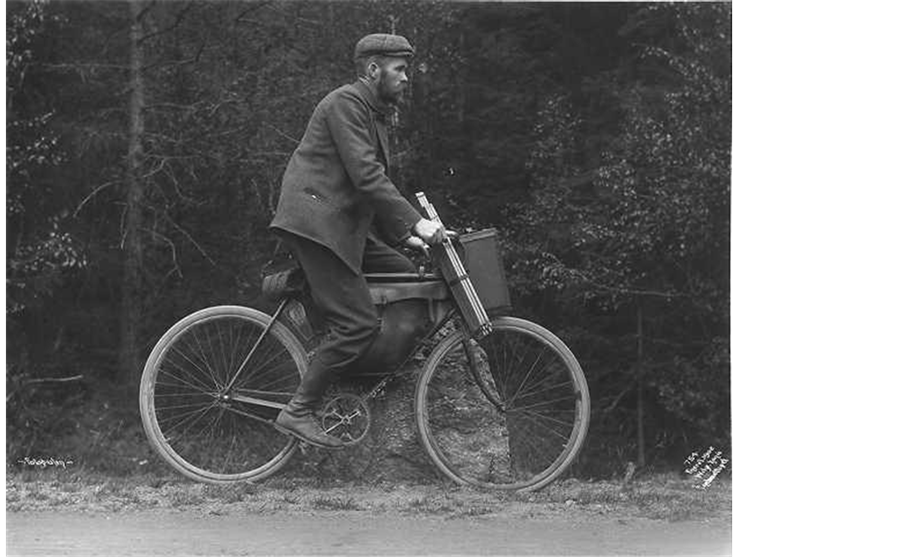
Picture 3. The Norwegian photographer Anders Wilse (1865-1949) cycling in 1902. Norwegian Folk Museum Oslo. NF. W00754
The first owners of bicycles were more well-to-do people in both rural and urban areas. This was mainly due to the high cost of a bicycle. One Swedish informant, who remembered the first bicycles in his parish around 1900, stated that only wealthy farmers’ sons were able to purchase them. In order to emphasise the specific and memorable owners of the first bicycles went to a photographer’s studio to have a picture of them with the bicycle. In one northern Norwegian district, the parish organist was the first to acquire a bicycle around 1900. He rode it back and forth on the road after church services for the sake of public display (MO 1964 No. 11 informant born in 1888, Troms County). This helped to accentuate social contrasts when not everyone could afford to acquire novelties such as a bicycle.
The price of the bicycles gradually went down so that ordinary people could afford to buy them. It was especially younger men who earned enough money to buy a bicycle. It was the norm that young people would first earn the amount of money needed to make the purchase (MO 1964 No. 26, Oslo). Loans were to be avoided even if the final amount could be paid in installments. It took several months of work to earn enough for a bicycle in the early 1900s in both Norway and Sweden. A Norwegian, born in 1894, stated that the few bicycles that existed in his youth cost 100 - 140 dollars apiece and that this corresponded to 5 - 6 months of work for a farmhand (MO 1964 No. 57, Rogaland County). The price could be reduced if you bought a second-hand bicycle. A Swede, born in 1898, bought his first bicycle in 1918. It was a second-hand purchase and cost him 65 Swedish crowns at a time when his salary was 20 Swedish crowns a month (IFGH 6341). A man from the Norwegian town Drammen who earned 20 Norwegian crowns monthly in 1904, bought a used bicycle for 75 crowns. The bicycle was in any case advantageous because it had a practical use and high social status.
4. Age and Gender
While bicycles were first acquired by younger males, their fathers were less interested. Many members of the parent generation objected to riding a bicycle. They were more sceptical of the cycle as a technical novelty. This was the case especially among the horse owners. On a farm the horse was the primary means of transport for the elderly, whereas younger men tried to get a cycle (MO 1981 No. 100 Ryfylke, Rogaland County). A factor that played a significant role in the bicycle’s childhood was when the bicycles were accepted in the peasant districts; they were useful to transport milk bottles to the milk trucks and dairies (MO 1981 No. 48, A man born in 1888, Østfold County). They were also used for trips to the local store where all items were hung on the handlebars or tied on the luggage carrier (MO 1981 No. 97, A woman born in 1907, Rogaland County).
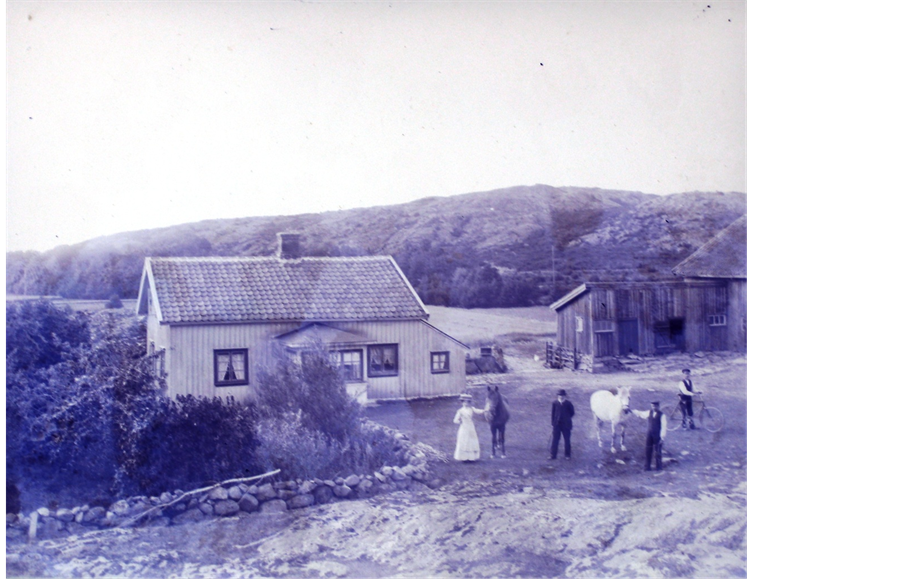
Picture 4. A farmer’s family in western Sweden in the 1920s. The husband and wife each display one horse for the travelling photographer. The grandfather stands with his cane in the middle. The teenager son is placed in the background with his bicycle. Photo Simon Martinsson. Privately owned.
When elderly men bought a bicycle, it was primarily for cycling to and from work. This saved time and was more convenient than walking. People in their forties and up found it harder to learn to ride a bicycle than younger people did. At the same time, learning was also problematic for the younger ones because bicycles were bulky and heavy. Children’s bikes did not exist at first, so children were taught on adult bicycles. They could not reach the bicycle seat and had to pedal with one leg under the bar on a man’s bicycle. Smaller bicycles came later and made it much easier to learn riding (DAGF1451, A woman born in 1942, Dalsland Province). It became common for young people to get a bicycle during their preparation for confirmation, or in connection with the confirmation ceremony in church, when they were fourteen years old. The young people then got a grown-up bicycle (MO 1996 No. 41, Østfold County). Furthermore, children had to ride on errands for their parents to the shops etc. and made it beneficial for the parents when the kids had a bicycle (DAGF 1444, A woman born in 1936, Blekinge County). From the age of ten I myself in the 1950s had to carry out errands for my parents on a farm in western Sweden. It was important for visiting the shop, the pharmacy, the bee-keeper’s farm etc.
Younger men found that social contacts were spatially extended thanks to the bicycle. This applied to both cities [4, p. 20] and countryside. The youth got the opportunity to travel away from their own community and meet other people. At weekends, it was tours to dance pavilions (ULMA 26747, Uppland Province, MO 1981 No. 139, Østfold County). Similar descriptions can be found both in Sweden and Norway. When young women got a bicycle, excursions were the main attraction, preferably with girl friends. Bathing was an important destination for the young women.
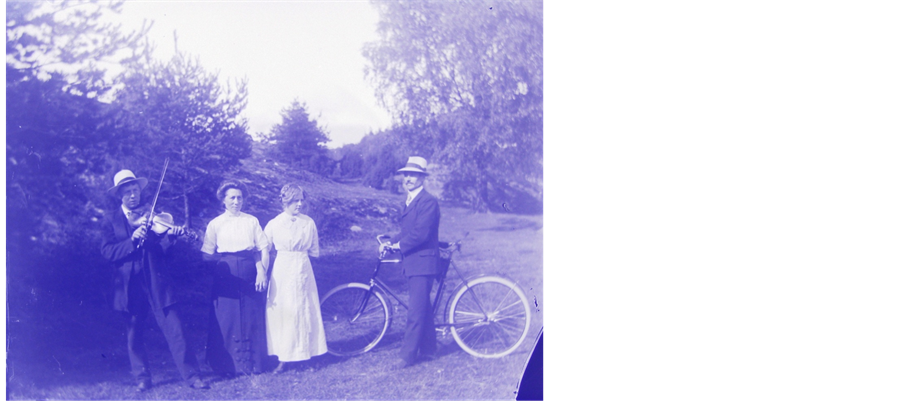
Picture 5. A young man who rode his bicycle to a dance pavilion in western Sweden. Photo Simon Martinsson. Privately owned.

Picture 6. A lady’s bicycle in the early twentieth century. The Nordic Museum, Stockholm.
Lady’s bicycles came somewhat later than men’s bikes, but they were not uncommon in the 1920s in Norway and Sweden (ULMA 26747, Uppland Province). Women needed a chain-guard to prevent their dresses and skirts from getting caught in the chain. Trousers were not considered appropriate for women to wear during the early 1900s. Stories are told about skirts being tied together and pulled up with help of a belt when riding a bike (MO 1981 No. 52, Rogaland County).
5. Leisure
With the regulation of labour in the 1920s [5], people got leisure time. Then there were opportunities for cycling in the evenings and at weekends and, from the 1930s, also during holidays in summer time. Long weekend bike rides together with some other young people are mentioned in many cases, both in Norway and Sweden. The two-week vacation in 1936 in Norway [6] (three weeks in 1947), and in 1938 in Sweden [7,8] (three weeks in 1951) meant that cycling tours could be arranged over several days with overnight stays under simple conditions in barns or in hostels. In some cases, cyclists were able to hitch-hike with trucks for some distances and get a rest from their strenous cycling. This was of particular value if cyclists had the wind against them as on the flat lands in Skåne and Denmark, for example (ULMA 30927, Uppland Province). Burning summer heat is also mentioned as being tiring. The scout movement arranged long bicycle tours. A diary preserved in southern Norway describes such trips with their heavy loads during the summer to Denmark (MO 1996 No. 4 Aust-Agder County).
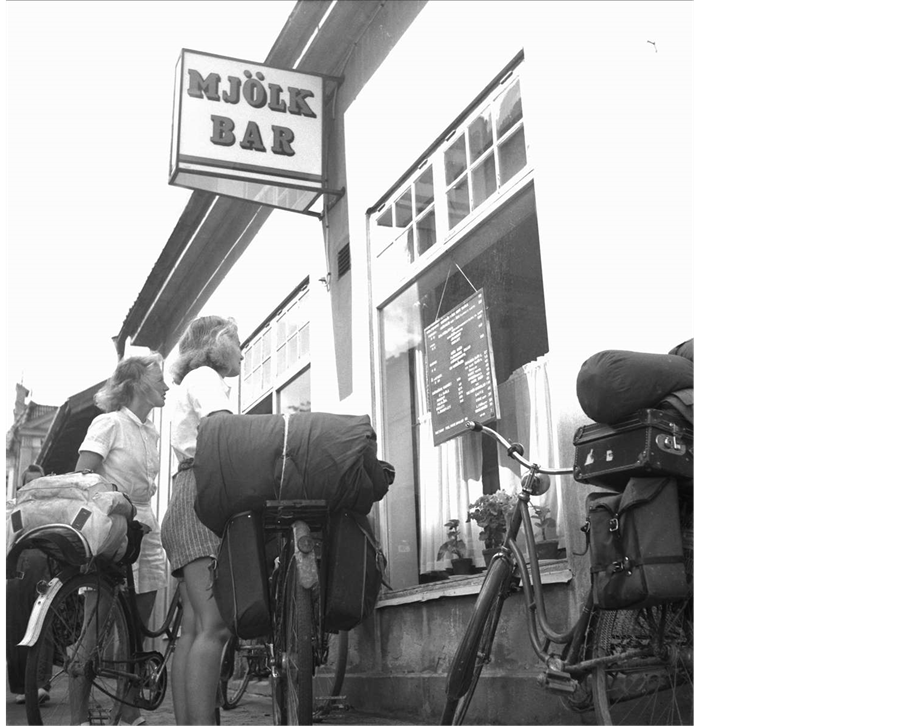
Picture 7. Two young Swedish women on a pause in front of a restaurant during summer holiday in the 1940s. The Nordic Museum, Stockholm.
6. Special Conditions during the Second World War
During the 1920s and 30s, bicycles began to get competition from cars. Some people abandoned their bicycles when they could afford a car. The Second World War changed the situation abruptly to the advantage of the bicycle, not only in German-occupied Norway, but also in Sweden. Private individuals had no access to cars. One problem the cyclists experienced was the total lack of rubber tyres. Therefore everybody was forced to endless repair work on old tyres (DAGF 1515, Västergötland Province, MO 1996 No. 7 Akershus County). At best, you could buy a bicycle tyre that was fit for use (MO 1996 No. 9, A woman born in 1933, Østfold County). Bicycle tours during leisure time and holidays did not come to an end; instead they were quite popular in the two neighbouring countries. A woman, born in 1930 in Hovås in Gothenburg, remembers how one had to carry clothing and household utensils on the luggage carrier when going to a summer home. Bicycles could then be so back-heavy that they could even rear (DAGF 1511 Gothenburg). In Norway, in addition, cycling out of the cities during weekends was aimed at trying to buy food in rural areas. This was an illegal black market action hidden from the German authorities (MO 1996 No. 17 Østfold County), who carried out checks on the contents of luggage on bikes. Such bicycle rides often took place at night (MO 1996 No. 31, A man born in 1909, Oslo).

Picture 8. A woman cycling in Oslo in 1941. A Nazi soldier in the background. Photo Anders Beer Wilse, The Norwegian Folk Museum, Oslo.NF.WF 15116.
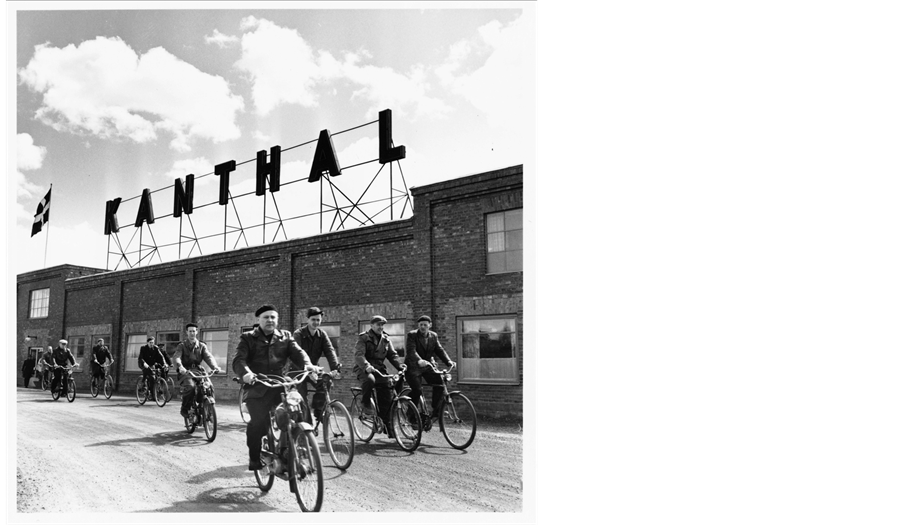
Picture 9. Factory workers cycling to and from their place of work in Stockholm during the Second World War. The Nordic Museum, Stockholm.
When War ended, Norwegians were able to ride across the border to Sweden to find scarce goods, especially clothing fabrics. Private cars did not exist to any great extent in Norway until 1960 [9, p. 83, 10]. Swedish goods were liable to custom duties, but customs officials were often lenient when they saw that smuggling women had wrapped several layers of fabrics around their bodies as they passed through customs on their bicycles. On the marriage front, Swedish men had an advantage in the Norwegian-Swedish border areas because they had cars whereas the Norwegian male youths came by bike. A Swede born near the border explained:
Swedish boys were very popular in Norway after the war. ....Norwegian boys stood there with their bicycles while Swedish youths came with their nice, big cars. And they picked up Norwegian girls [11].
7. Dangers of Cycling
Balance is important in cycling. It was something that no one had learnt previous to the introduction of the cycle. It was especially difficult to learn to ride a velocipede with its high front wheel. In Norway it was called “Veltepetter” (Peter Tip-over). In his diaries from 1880s, Alban Thorburn from the town of Uddevalla (see Picture 2) often tells about the falls he took during his journeys all over Europe. On 27 May 1884, he fell over twice on the same day, frightening two approaching horses. Adults often tried to learn riding a bike but many gave up after having made a few attempts. One Swedish spokesman said: “Dad tried when he was 45, but soon relinquished the idea” (ULMA 25223 Gästrikland Province). A man in northern Sweden tried to learn when he was 61 in 1914, but he hurt himself badly when riding down a steep hill (ULMA 31678, Ångermanland Province). The fixed hubs made it impossible to brake with the rear wheel, which then had to be done with the handbrake, which was more difficult (MO 1981 No. 25 Oslo). The art of slowing down and simultaneously maintain balance at high speed took a long time to learn. When children were taught to ride on adult bicycles, this not only led to many overturned rides (DAGF 1440, A woman born in 1928 Gothenburg, MO 1996, A man born 1916, Oslo), but also to collisions with pedestrians or with other cyclists (MO 1964, A man born in 1885, Rogaland County). The risk of accident was greater when several persons rode the same bicycle (MO 1964 No. 77, born in 1894, Oslo). There were also mishaps when skirts or bathrobes jammed inside the wheel, leading to a fall from one’s bicycle (DAGF1519, A woman born in 1933 in Gothenburg).
The shame felt after a tumble was mentioned by those who had experienced this personally. A man born in 1916 in Oslo said: “I did not tell anyone about my fall then and I have not done it later. I was ashamed about what had happened” (MO 1996). A fall could mean that not only the rider but also the luggage could be damaged. A situation like this was particularly dramatic in the Second World War if rationed goods were spoilt. A Norwegian woman born in 1926 told of her fear when she went to fetch her mother’s extra ration of 5 kg of jam sugar. The entire ration in a paper bag on the carrier was destroyed when she slid and fell on loose gravel. Her mother wept bitterly over this bad happening (MO 1996 No. 15, Akershus County).
A major problem at the introduction of the bicycles was the bad road conditions in rural areas, especially in winter and at the spring thaw. It was extremely difficult to keep balance when the deep ruts caused by horse carriages were filled with ice or water. Bicycle wheels easily got stuck in these tracks. It often proved to be necessary to walk the bicycle over lengthy distances before you came to a better road (MO 1981 No. 65, AustAgder County, MO 1964 No. 57, Buskerud County). This is often mentioned with reference to the mountain areas in Norway and the islands in the northern Norwegian archipelago. One had to try to ride alongside the deep ruts. Many accidents are mentioned in the recorded material. Cycling was therefore concentrated to the summer months in the countryside (ULMA 25223, Gästrikland Province).
Punctures often occurred. During longer trips it was necessary to carry a repair kit with you to fix a puncture. It was not easy to find a repair man within a reasonable distance. One might have to walk the bicycle long distances. Children usually had to walk their bicycles home and ask parents to fix whatever was damaged (DAGF 1451, A woman born in 1942, Dalsland Province).
It is only recently that separate cycling roads have made cycling safer at the same time as the number of cars has increased significantly. Cyclists have expressed anxiety about the numbers of cars that compete for space on roads used by cyclists. One can speak of a conflict of interest. A woman, born in 1933 in Västergötland county, who loved riding her bicycle, said that “road traffic destroys much of the joy of cycling” (DAGF 1518).
Unlike bicycle paths, which increased security, problems with thefts have grown significantly. This was something that the older spokesmen had never feared earlier. A man born in 1918 in Gothenburg stated that even during the 1950s, bicycles were never stolen even if they were left unlocked [4, p. 11]. The risk of theft ought to have been greater earlier when there was a shortage of bikes, but according to the records this hasn’t been the case. Bicycles could be borrowed from each other. Social moral constraints emphasized the seriousness of stealing from others.
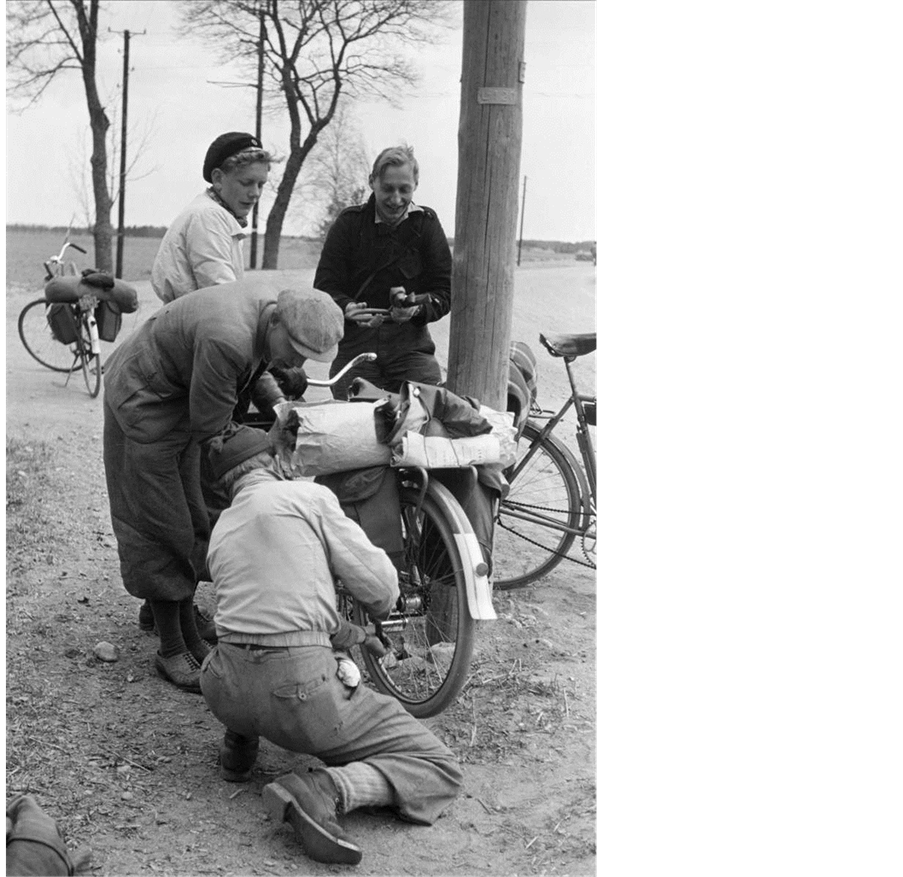
Picture 10. A punctured rear tyre during a summer excursion in 1940. The Nordic Museum, Stockholm. Number 0039680.
8. Collegiality, Cooperation
To begin with, no more than one cycle existed on each farm or each family. As long as there was a shortage of bicycles a certain collegiality existed which implied that several people could use the same bike in the same household. Younger siblings borrowed from the older ones and in that way learned how to cycle. More than one person could ride the cycle at the same time. Passengers could sit on the luggage carrier, the men’s rod and the handlebars of the bicycle. Even people outside the immediate family were allowed to borrow bicycles (MO 1981 No. 100, Rogaland County). This would seem to indicate generosity.
There were many instances of the fact that several cyclists could use the same bicycle on their way to and from their jobs or on excursions. A Swedish man, born in 1904, stated that when several workers were sent to work in the forest, they often agreed to share a bicycle. The first man rode the first distance. Then he lay the bicycle on the roadside and continued on foot. The next man rode the next distance before he put the bike on the roadside to be used by the man following after etc. They continued like this until they reached the working place (DAGF 1453 Östergötland County). Similar data are characteristic of Norway both in towns and on countryside (MO 1981 No. 19, A man born in 1886, Buskerud County). When the father of four boys in Oslo bought a used bike for his sons, the four brothers agreed that they would ride the bicycle a quarter of an hour before the next one was allowed to continue. This was joy riding in the central Greenland district of Oslo. A wall clock in the square was checked carefully by the brothers so that none of them rode more than a quarter of an hour (MO 1981 No. 53 Oslo).
Envy was expressed in contrast to collective collegiality. A young Norwegian man who had bought a new bicycle with his own money was so happy about this that he wanted to display his vehicle to other people. He didn’t always get positive comments from the environment. One neighbour who saw the new bicycle said: “There must be an old woman chasing you, I see”. The bicycle owner was very saddened by this remark (MO 1981 No. 10 Rogaland County).
9. Positive and Negative Reactions from the Surroundings
A common reaction to the new and unfamiliar velocipedes and bicycles was wonder about something totally different from what people were used to. Earlier it had only been a matter of walking or riding the horse that mattered. Owners of a velocipede gladly displayed their vehicles and attracted many astonished spectators. This is mentioned among others by a woman born in 1872 in the western Swedish town of Strömstad (IFGH 5761). From Tensta in Uppland, Sweden a spokesman told of how he stood in a crowd around 1900 and admired the first bicycles in the parish (ULMA 19048).
When people became more accustomed to seeing a velocipede, humorous hecklings to the cyclists could occur. A man who studied at Trondheim University in Norway acquired a velocipede to get home more easily. His comrades called out to ask him how much higher the temperature on the high wheel was (MO 1964 No. 63, Østfold County).
The first velocipedes and bicycles did not only attract positive attention but also led to fear, as is evidenced in many records. Elderly people did not like the fact that the horses were frightened by the early velocipedes and bicycles. These were the first vehicles that moved faster than horses. So the term “run-away machine” could be used (MO 1981 No. 7, A man born in 1907, Rogaland County). Bicycle wheels were compared to spinning wheels (IFGH 6521, Halland Province). Another expression was that the bicycle was a “cartwheel parable” (IFGH 4469, A man born in 1876, Bohuslän County).
In addition to horses many people were also scared. Children would run away and hide. Among the older people the first velocipedes and bicycles could be perceived as a danger of supernatural character and be associated with the devil. A Swedish woman, born in 1833, saw a man on a summer day in the 1880s riding a velocipede at high speed down a hill. She was absolutely terrified and thought that the devil himself had come rushing on the road. A few days later she was told that it was the parish blacksmith who was out on his self-produced vehicle. That made her ashamed of her fear (ULMA 25223, Gästrikland Province). The technical novelty of the cycle could in the folklore narratives also be considered to foretell the end of this world. A Norwegian spokesman reported that a woman living on an island in northern Norway was so scared when she saw a bicycle for the first time that she sat down on the roadside and exclaimed that this meant the end of the world (MO 1964 No. 10, Nordland County).
As the first bicycles were mostly found in higher social strata or among those who had worked to save enough money to buy a bicycle, there was, in some cases, jealousy among neighbours. It could at worst lead to damage done to bicycles such as letting the air out of the tyres, or even worse to harming them. Some young men were really rough on bicycles while young women could orally demonstrate their jealousy towards other young women who had got their own bicycle (MO 1996 No. 46, A woman Østfold County).
10. Feelings of the Riders
Among cyclists the expressions of positive feelings are clearly in majority. The negative aspects are earlier mentioned in Section 7 “Dangers of cycling”. Children showed their joy in learning to ride a bicycle. This was thought of as a friend that gave much of fun. A woman got a big bicycle when she was six, and she could not reach up to the bicycle seat. Nevertheless she was so happy and related: “My bicycle was my best friend who could carry me to different friends. ... I was so happy, so radiant with joy, and I placed it so that I could see it from my window every day” (DAGF 1447 Gothenburg). A woman in Stenungsund said: “I was really happy when I could ride a bike. What a wonderful feeling of freedom it was to ride with the wind whistling in the face and hair” (DAGF 1519 Bohuslän County). In some cases, little girls took over their mothers used bicycles and this was sometimes not seen as being positive. They longed to get a girl’s bicycle.
Adolescents stress the feeling of freedom they felt when being able to move faster than before and reach an outside local community to meet other young people. This was true of both cities [4, p. 20] and rural areas. At weekends they cycled out to dance pavilions (ULMA 26747 Uppland Province, MO 1981 No. 139 Østfold County). Many cyclists appreciated the feeling of the wind blowing and, not least, in summer time the scents, sights, smells, and wildlife in nature. Comparable descriptions can be found in responses from Sweden and Norway. When young men had a bicycle and not the young women, they often could offer rides on the bar when going to dance pavilions. Such young men described how happy they were to have a girl on the bar and to receive a kiss as a thank after the ride. A man, born in 1932 in Lilla Edet in Västergötland Province, said: “that sense of happiness lasted until I got home” (DAGF 1515).
Cycling to and from work also aroused many positive emotions. A woman from Varnhem in Västergötland Province cycled 13 kilometres every day to and from her place of work. She said: “I really enjoy it. ... I often see hares, deer, foxes, and in the spring lots of cranes. ...You get exercise and the air is filled with birdsong” (DAGF 1512). Similar thoughts have been expressed by those who made daily bicycle tours for fun and those who went on cycling vacations both earlier and later in time. A woman whose family had a cycling holiday in 1983 stated: “The best thing about cycling is that you are so free. Now we can stay where we like it and do whatever we want. We usually keep an eye on the map to watch for different sights and natural heritage so that we can stop and look at them as we pass” [12]. Several Swedish informants said that the joy they felt when they received or acquired the first bicycle during the early 1900s was much greater than the joy they experienced later in life when they bought a car. This is also true in Norway where there were hardly any private cars from 1940 to 1960 (MO 1981 No. 9 Aust-Agder County, MO 1981 No. 10 Oslo, MO 1996 No. 18, A man born in 1925, Østfold County).
When the shortage of bicycles was at its height, it was important that they would be maintained, lubricated and cleaned before being used during the summer. This indicates of the mental worth of the bicycles for the owners. A woman born in 1933 in Gothenburg explained in detail about this procedure (DAGF 1519). It was also important that the bicycle was kept under the roof. If not, children and young people were reprimanded by their parents (DAGF 1451, A woman born in 1942, Dalsland Province).
Clairvoyant persons have related that they could encounter supernatural beings and deceased persons while they were out on a bicycle ride. Modern technology has therefore not been an obstacle to the survival of older folk beliefs. One farmer, born in 1904 on the island of Tjörn in western Sweden, belonged to a free church congregation. He described several experiences of contacts with a supernatural world, especially with ghosts. He told of how he had met the teacher he had had in his first grade class outside the school house.
I came cycling along and had just been to the chapel. A woman in a long skirt was walking along the road, but it was impossible to catch up with her. When she got to the bend by the school house, she disappeared. And I think that it was the teacher who was walking there. …I had been in that teacher’s class some months, but then she died. When I saw her walk up the hill, she had been dead for many years. I recognized her by the clothes she wore.
This was said to have taken place about 1920, a short while after the informant had acquired a bicycle in 1918 [13, p. 168].
The idea of the environmental benefit of cycling has begun to be discussed in the media in recent years, but the recorded material under study has only a few details of this. Thus a woman born in 1931, who was a teacher and who cycled to her place of work for many years, is the one person who most clearly emphasized the environmental aspect: “I feel responsible for the environment. The bicycle is a fantastic invention, it does not pollute the air nor waste the earth’s resources. That is why I take the bicycle instead of the car even though I have had a car since 1952” [4, p. 7].
11. National Aspects on the Cycling
No really significant differences concerning the innovation of cycling have been found in the neighbouring countries of Norway and Sweden. This is in contrast to the results of my earlier studies on gravestone symbols and memorial websites on the Internet in recent times [14]. Norway lived under extremely challenging conditions during the German occupation in the Second World War. However, in Sweden as well, the War was clearly evident as bicycle tyres were in short supply. One difference between the countries at that time was that riders in Sweden were not subjected to the checks carried out by the German authorities in Norway. Even after the War ended, national differences were still apparent as Norwegians did not have private cars to any significant degree until 1960. The bicycle therefore continued to be more important than in Sweden for transportation and vacation tours. Another difference between the two countries is that road conditions during the early 1900s were significantly worse in Norway than in Sweden, due to the many and steep valleys in the western part of Norway and the isolated islands in northern Norwegian archipelago.
References
[1] Vivanco, L.V. (2013) Reconsidering the bicycle: An anthropological perspective on a new (old) thing. Routledge.
[2] Internet source. www.hf.uio.no/ikos/tjenester/kunnskap/samlinger/norsk-folkeminnesamling/
[3] Ekström, G. (1984) Svenskarna och deras velocipeder. Hudiksvall.
[4] Hultstrand, K. and Kohlrusch, B. (1986) Cykla bör man. University of Gothenburg, Gothenburg.
[5] Svensk författningssamling (1982) 673. Stockholm.
[6] Ferieloven (2009) Store norske leksikon. http://snl.no/ferieloven
[7] Hesselgren, O., et al. (1972) Semesterlagen. Stockholm.
[8] Svensk författningssamling (1977) 480. Stockholm.
[9] (1999) Gränsmöten. Ed. by Rolf Danielsson & Anders Gustavsson. Strömstad.
[10] Skåden, K. (2004) Frembringelser av Tyskland i Norge: Med utgangspunkt i arbeidet for bilsamfunnet 1936-2002. Oslo.
[11] Gustavsson, A. (2000) Living near the Swedish-Norwegian border in the 20th century. Volkskultur und Moderne. Europäische Ethnologie zur Jahrtausendwende, Wien.
[12] Arbetet Väst June 16, 1983.
[13] Gustavsson, A. (2012) Cultural studies on folk religion in Scandinavia. Oslo.
[14] Gustavsson, A. (2011) Cultural studies on death and dying in Scandinavia. Oslo.
Unprinted Sources Gothenburg The Folklore Archives (DAG)
Free records Responses and pictures on the questionnaire “Bikes and bikers yesterday, today, tomorrow”
Oslo The Folklore Archives at the Department of Cultural Studies and Oriental Languages, University of Oslo (IKOS)
Autobiographies (MO) collected in 1964, 1981 and 1996 The Norwegian Folk Museum (NFM)
Digital Museum Stockholm The Nordic Museum (NM)
Digital Museum Uddevalla The Bohuslän Museum (BM)
Photos Uppsala The Folklore Archives (ULMA)
Free records
NOTES

*Paper presented at the SIEF Congress in Tartu, Estonia 1-4 July 2013, within the panel Cycling: past, present and future. At this panel five Swedish papers and one from Hungary were presented. After the panel discussions it was decided to start an international research network with the topic of cycling.

